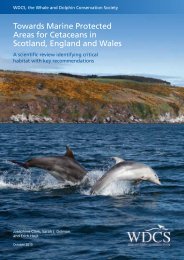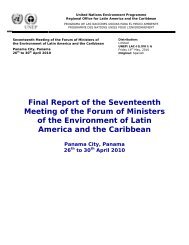Caribbean Environment Programme - UNEP
Caribbean Environment Programme - UNEP
Caribbean Environment Programme - UNEP
You also want an ePaper? Increase the reach of your titles
YUMPU automatically turns print PDFs into web optimized ePapers that Google loves.
<strong>UNEP</strong>(DEC)/CAR WG.18/6<br />
Anexo V<br />
Apéndice 2<br />
Página 12<br />
There are three lines of action that the office PAHO in the <strong>Caribbean</strong> has identified,<br />
which could lead to improvement of municipal sewage disposal in the English <strong>Caribbean</strong>:<br />
1. Resource Mobilization<br />
• Innovative approaches to resource mobilization (using non traditional donors).<br />
• Making Government officials aware of the critical nature of resource mobilization to improve<br />
municipal sewerage.<br />
• Promotion of private sector involvement<br />
2. Area of Technology<br />
• Support to construction of cluster sewerage system for specific area where construction of<br />
onsite disposal is not possible.<br />
• Promotion of community financed onsite system.<br />
• Support of research of package plants for domestic wastewater treatment.<br />
• Promotion of septage lagoon type for treatment of septic sludges.<br />
• Promotion of innovative treatment technologies such as sea outfall, wetland gardening for<br />
small systems.<br />
3. Policy Orientation<br />
• Promotion of CARICOM policy on disludging ( transport and disposal of sludges).<br />
• Promotion of national regulations for treatment of septic sludge (at landfill or disposition<br />
treatment plants).<br />
• Zoning & physical planning resolution for squatting development.<br />
• Promotion & reinforcement of existing policy.<br />
• Community health education.<br />
OVERVIEW OF PAHO TECHNICAL COOPERATION ACTIVITIES<br />
UNDER THE PERSPECTIVE OF THE GPA<br />
Gerardo Galvis<br />
La OPS/OMS, en equipo con UNICEF y con grupos de trabajo nacionales, evalúa<br />
periódicamente la situación de agua potable y saneamiento (AP&S) en la Región de las<br />
Américas. Evaluación 2000, se realizó con base en el análisis de datos de 1998 y en informes<br />
analíticos de los países. Informacíon sobre Evaluación 2000 está disponible para consulta y<br />
opiniones en http://www.cepis.org.pe/eswww/eva2000/eva2000.html. A pesar de los avances en<br />
la cobertura de AP&S en la Región, aún 76.5 millones de personas (15,4%) no tienen acceso<br />
fácil a opciones adecuadas de abastecimiento de agua y otras 53.9 millones (10,9%) se abastecen<br />
con sistemas sin conexión domiciliar. De otra parte, 103.2 millones (20.8%) no tienen acceso a<br />
soluciones adecuadas de saneamiento. Además, existen grandes iniquidades en las coberturas.<br />
Los porcentajes de población rural en la Región sin acceso adecuado a AP&S son del orden de<br />
cinco veces más altos que en la población urbana. Además, las familias pobres gastan<br />
proporcionalmente en estos servicios que las de mayores ingresos. En LAC, el 48.6% de la

















